The following article is reprinted with permission from The Jewish Religion: A Companion, published by Oxford University Press.
There is much truth in the observation by the pioneering historian, Leopold Zunz, that the Jewish Middle Ages lasted until the end of the eighteenth century, in that the currents of thought and life which followed the Renaissance and shattered the medieval picture largely passed by the Jews. Confined in the ghetto, European Jewry, constituting by far the largest segment of Jewry at the time, cultivated its own traditional way of life until the Western world and its culture was opened to the Jews after the French Revolution and the subsequent Jewish Emancipation.
The Jewish Enlightenment
Yet already in the second half of the eighteenth century, the Haskalah (Enlightenment) movement had its aim certainly not the disavowal of traditional Judaism but the encouragement of the new science and learning among the Jews, of an openness to Western ideas and norms that might result in a rationalist approach to the tradition, and a general widening of Jewish horizons. The Haskalah did not necessarily imply that Jewish observance should be abandoned. Many of its adherents, the maskilim, were totally observant in their private lives.
Nevertheless, the traditionalists were bitterly opposed to the Haskalah, fighting it with every means at their disposal. And the Maskilim were not content with the introduction of the new learning into the Jewish schools. The traditional method of Torah study, with its complete emphasis on the Talmud and codes of Jewish law and without any systematic approach to education, also came under attack. The Maskilim urged a return to the study of the Bible in its plain meaning, unencumbered, as they saw the ideal, by the older type of rabbinic exegesis.
With your help, My Jewish Learning can provide endless opportunities for learning, connection and discovery.
New Reforms

The Haskalah paved the way for the emergence of the Reform movement in early nineteenth-century Germany, a movement that posed the severest threat to the traditional way of Jewish life. It was in Germany, in the first instance, that the Jew who had recently emerged from the ghetto to take his place in Western society experienced the tension between the traditional way of life and the allure of the new ways. Some of the more intellectual and wealthy Jews were so enamored of the German culture that they cast off entirely what they considered to be the fetters of tradition, to become completely assimilated even to the point of converting to Christianity.
Early Reform in Germany was not a negative movement. On the contrary, it had the positive aim of stemming the tide of apostasy, declaring that Judaism still had the power of truth to hold its adherents, if only some of the Jewish institutions were recast and the religion reformed so as to make less marked the difference between the Jew and his Gentile neighbor.
At first, the reformers introduced comparatively minor changes in the liturgy. They removed some of the less inspiring prayers from the prayerbook; introduced some new hymns in German; brought in an organ accompaniment to the prayers; and inculcated a greater sense of decorum in the Western style. Sermons were also introduced. The most far-reaching of the early reforms was the abolition of prayers for the restoration of the sacrificial system and for the return of the Jews to their ancient homeland, thus involving a complete reinterpretation of Messianic hope. The supernatural elements in messianism were disregarded as were the more pronounced particularistic elements in the traditional faith.
The messianic vision, to which they were faithful, meant for the Reformers the emergence of a better world in which liberal ideas would triumph. The prophetic theme that Israel would become a light to the nations was understood by Reformers not to refer to a Jewish people in the Holy Land, spreading from there the truth about God and His relationship to peace, justice and freedom. The Reformers understood Judaism as “ethical monotheism,” with its institutions not as divine laws but as human means of furthering this ideal until it became the religion of all mankind. From this view point there followed the idea that the dietary laws, for example, had played an important role in assuring Jewish survival in the past but could now be a hindrance in that they frustrated social relationships between Jews and Gentiles.
A Break with Tradition
The polemics between the Orthodox, as the traditionalists came to be called, and the Reformers were fierce. The Orthodox treated Reform as rank heresy, as no more than a religion of convenience, which, if followed, would lead Jews altogether out of Judaism. The Reformers retorted that, on the contrary, the danger to Jewish survival was occasioned by the Orthodox who, through their obscurantism, failed to see that the new challenge facing Judaism had to be faced consciously in the present as Judaism had faced, albeit unconsciously, similar changes in the past.
From Germany the Reform movement spread, becoming particularly active in the New World, where the most influential American Jews, led by German Reform rabbis, adopted Reform wholeheartedly. Since World War II, however, in many Reform circles, a greater awareness of traditional values has become evident. Some reform Rabbis have argued for a greater appreciation of halakhah [traditional Jewish law and practice], which, they maintain, possesses its own wisdom and insight.
Talmud
Pronounced: TALL-mud, Origin: Hebrew, the set of teachings and commentaries on the Torah that form the basis for Jewish law. Comprised of the Mishnah and the Gemara, it contains the opinions of thousands of rabbis from different periods in Jewish history.
Torah
Pronunced: TORE-uh, Origin: Hebrew, the Five Books of Moses.


